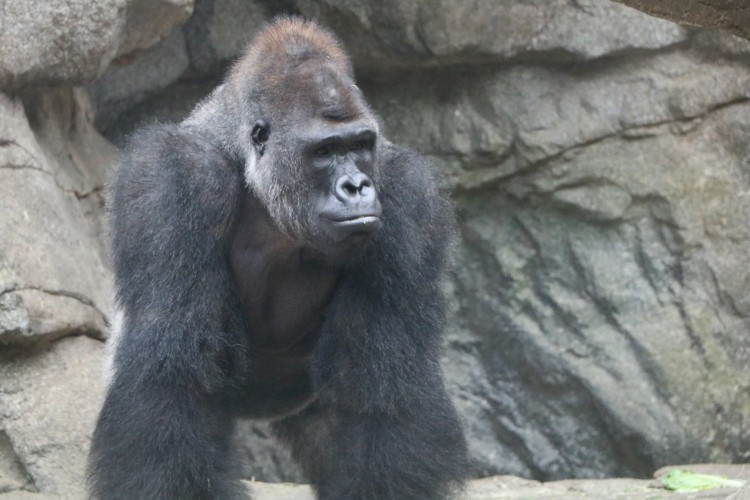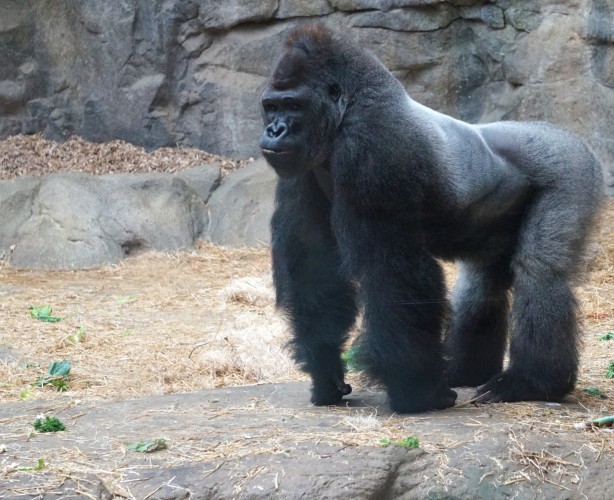This is an archived article and the information in the article may be outdated. Please look at the time stamp on the story to see when it was last updated.
NEW ORLEANS — Okpara, a Western lowland gorilla, is settling into his new home at Audubon Zoo.
His recent move from Franklin Park Zoo is an integral piece of a larger plan to help bolster the population of this critically endangered species.
Since early December, the 24-year-old male silverback gorilla, affectionately known as “Okie,” has resided behind the scenes as animal care providers and veterinary staff completed a standard quarantine protocol to ensure that new arrivals like Okpara don’t bring health-related problems with them that could cause problems for the existing animals under Audubon’s care.
“With any new animal – whether it’s a reptile, a bird or a mammal – they must go through a diagnostic process,’’ said Courtney Eparvier, curator of primates at Audubon Zoo.
During a quarantine, Audubon Zoo veterinary staff take fecal samples looking for parasites, administer a TB test and perform blood analysis that can reveal evidence of an infectious or contagious disease or virus an animal may have been exposed to.
“All zoos accredited by the Association of Zoos and Aquariums (AZA) are expected to have quarantine protocols for incoming animals,’’ said Dr. Robert MacLean, Audubon Nature Institute senior veterinarian.
The quarantine also provides a valuable settling-in period for a new arrival and the Audubon team of animal care professionals.
Okpara is joining another recent arrival – Tumani, a 10-year-old female Western lowland gorilla from the Cheyenne Mountain Zoo – and Praline, a female who is the last gorilla born at Audubon Zoo 21 years ago.
Eparvier, Audubon’s primate curator, said Okpara has adapted well to his new environment.
“This is his new home now and he needs to kind of see who we are; and we have to put the time in to get to know him,’’ she said. “So far, it’s been great. We’re starting to get to know his personality, his behaviors. We’re also in there to keep him company, establishing our relationships with him.’’
Eparvier, who got to spend time with Okpara before he left Franklin Park Zoo, said she’s happy to see he hasn’t changed much since he arrived here.
“He’s a very boisterous silverback and has quite a large personality’’ she said. “He’s not shy at all. And one thing that I’ve noticed working with him is when we’re preparing his diet or creating some enrichment for him, he’s just always watching and very inquisitive. He’s not standoffish or aloof.’’
Casey, the lone male in the former gorilla troop who did not produce offspring despite being paired with four females during his 15 years at Audubon Zoo, departed for Louisville Zoo in June. His exit was tough on the Audubon animal care staff.
“Casey was such a huge presence in our everyday lives and he will always have a special place in our hearts here,’’ Eparvier said.
“But Okpara coming in is starting to fill that hole. He’s now going to be the man of our group here taking charge as the silverback and we couldn’t be more excited to get him out of quarantine and introduce him to our girls.’’
The new Audubon gorilla troop may not be visible to the public for a time as Okpara and two females engage in a structured introduction process to ensure they bond socially. Animal care experts emphasize that this is an important step toward establishing a cohesive unit.
Like all great apes, gorillas are in danger of extinction due to habitat loss from unsustainable agricultural and mining practices.
Franklin Park Zoo and Audubon Zoo are active participants in the Gorilla Species Survival Plan (SSP), a cooperative, inter-zoo program coordinated nationally through the Association of Zoos and Aquariums (AZA). Species Survival Plans help to ensure the survival of selected species in zoos and aquariums.
Each species has an advisory board of experts who consider the parentage and genetic information of every animal in the system to determine which ones would make the best match at the time given the current gene pool. The panel strives to maintain the genetic variation that a species would get under ideal conditions in the wild.
Very few zoo animals are brought in from the wild and fewer still will return there. Instead, they are bred and live under human care, serving as the ambassadors for their counterparts in the wild – ideally as a healthy, genetically diverse population designed to avert extinction.
The AZA’s Gorilla Species Survival Plan manages 350 gorillas in 48 North American zoos, including a dozen born last year. Many gorilla populations have declined or disappeared over the past few decades. The Western lowland gorilla is critically endangered, with an estimated population of 100,000.
7-Day Forecast
7 Day Forecast
- Humidity
























